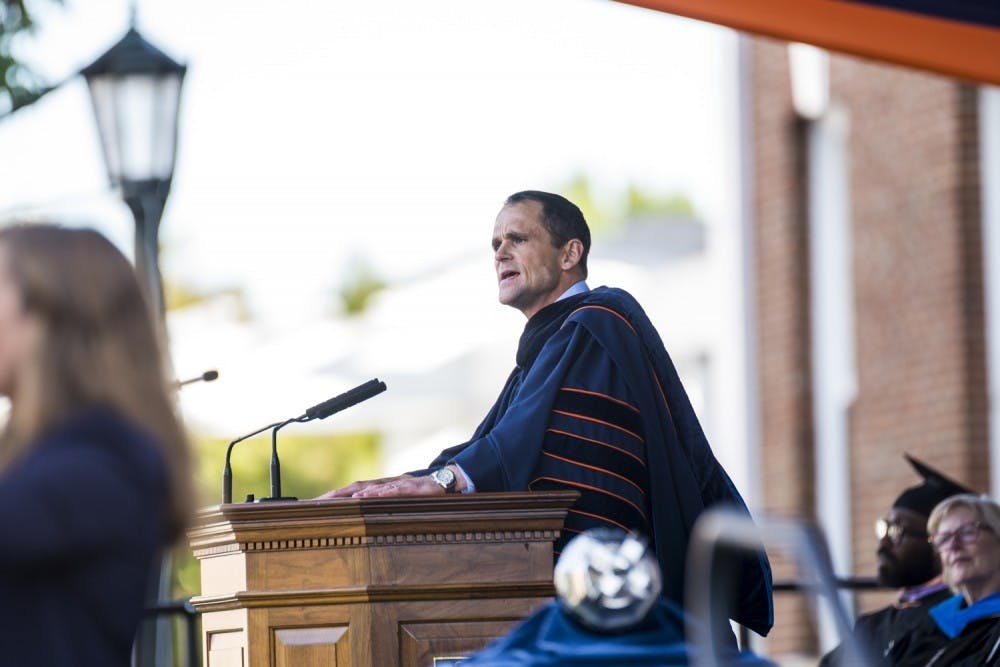University President Jim Ryan’s promise to guarantee financial aid for low- and medium-income students may not be a major departure from current financial aid practices.
In mid-October, Ryan announced at his inauguration that students from Virginia families earning less than $80,000 per year with “typical assets” — average amounts of savings and investments — will be able to attend U.Va. tuition-free. Students from Virginia whose families earn less than $30,000 per year with typical assets will be eligible for free room and board on top of the free tuition.
Just under 12 percent of U.Va.’s approximately 16,000 undergraduate students will qualify for the newly-announced policy to allow low- and medium-income families from around Virginia to attend the University at reduced costs, according to data from Student Financial Services.
But in an interview with NBC29, Ryan said his proposal wasn’t a significant change in SFS’ practices.
“What I asked our team to do is to calculate the grants that we give the families earning under $30,000 and under $80,000,” Ryan told NBC29. “And when they did, that they realized that we were coming really close to paying for — through grants — tuition, room and board for families earning under $30,000 and paying tuition for families earning under $80,000.”
University Spokesperson Anthony de Bruyn said in an email to The Cavalier Daily that 600 currently-enrolled in-state students fall under the $30,000 annual income threshold, and 1,300 currently-enrolled in-state students fall within the $30,000 and $80,000 threshold.
De Bruyn said the University is committed to the plan — which codifies existing practices into policy — and hopes that the new financial aid system allows for more individuals to engage in beneficial opportunities.
“While current UVA financial aid essentially meets this commitment, we believe it’s important to make an explicit promise that this is what we are going to do going forward as part of UVA's commitment to Virginia's low- and middle-income families,” de Bruyn said. “Opening doors of opportunity is one of our highest callings as a public university.”
De Bruyn said that only grants — not loans, which must be paid back — will be given to students whose family incomes fall below $80,000 to cover tuition, and to students whose family incomes fall below $30,000 to cover tuition, room and board. Loans may be given to cover other unofficial costs of attendance, such as travel or books, de Bruyn added, and federal work-study programs may still be included in aid.
While some are hopeful that the financial aid plan will improve the accessibility of opportunity at U.Va., they have expressed skepticism about the specifics of the plan.
Francesca Callicotte, a fourth-year College student and president of United for Undergraduate Socioeconomic Diversity — or UFUSED — said she supports the policy but wants to see if it will make a difference.
“I think that with anything we’re promised at this University it’s always great to have some healthy dose of skepticism,” Callicotte said. “President Jim Ryan’s address was wonderful — I think that the initiative itself seems great.”
Assoc. Education Prof. Walter Heinecke also said he would like to see a more detailed elaboration on the proposal and its influence on admissions.
“I’d like to see how this policy might influence U.Va.’s admissions policy in terms of socioeconomic diversity as well as racial diversity,” Heinecke said. “So I think it’s an excellent aspiration and I totally praise President Ryan for his commitment to equity here, I’d just like to see how this works out in the details.”
As the University is one of the only public “need-blind” admissions institutions across the country, it does not consider financial status when making admissions decisions.
De Bruyn noted that the emphasis of the plan will begin with the incoming Class of 2023. However, the plan will also apply to current students.
“Current programs will stay in place,” de Bruyn said. “This promise will be focused on members of the Fall 2019 incoming class, but applies to all current undergraduate students as well. Current undergraduate students will apply for financial aid as normal and be evaluated for eligibility for this promise even if the student has not received financial aid in the past.”
Callicotte said she thinks that the new plan will bring a new focus to students throughout the socioeconomic spectrum.
She also said she hopes the new financial plan could create a more diverse student body in upcoming years, noting how the promise would potentially enable a wider variety of individuals to harness opportunities presented by higher education.
“I would want this initiative to bring in students who bring in valuable experience that isn't usually seen and or articulated at this University,” Callicotte said.
Joshua Farris, a fourth-year Curry student and co-director of Student Council’s inaugural U.Va. AL1GN Conference — a forum that will occur in March with the purpose of connecting first generation and low-income students — said he hopes decreased costs could help students feel more comfortable at the University. Farris emphasized the importance of retaining first-generation and low-income students and hopes that in this effort, the plan will expand to consider the costs of extracurricular activities as well.
“Addressing all these social and emotional needs — I think that increases [low income and first generation students’] sense of belonging as well as their social capital [which] might reduce attrition and increase the graduation rate,” Farris said.
Ellie Brasacchio, a third-year College student, chair of the Student Council Representative Body and co-director of the AL1GN Conference, said she sees the proposal as a continuation of a fundamental change she has observed at U.Va. — and could result in more low-income and first-generation student voices being heard at the University.”
“I've already been seeing a change within U.Va. … with [the proposal’s] emphasis on first generation and low income students,” Brasacchio said. “It's a fairly new thing — people are just now starting to talk about [accessibility for low-income and first generation students] and starting to get excited about it.”







